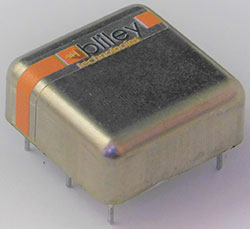
To support the increasing number of commercial low earth orbit (LEO) satellite constellations, Bliley Technologies developed the Iris master reference oscillator. The 100 MHz oven controlled crystal oscillator (OCXO) was designed to be radiation tolerant for both the total ionizing dosage (TID) and linear energy transfer (LET) levels encountered by LEO satellites. The Iris series is tolerant to at least 40 kRAD TID and 40 MeV LET. The OCXOs’ low power dissipation and small size, compared to traditional space OCXOs, supports the constraints of LEO payloads. Biased with a nominal 5 V supply, the OCXO dissipates 1.5 W steady-state (3 W maximum at start-up). Its size is 1 in x 1 in x 0.46 in.
Designing the Iris for LEO satellites did not sacrifice oscillator performance. The phase noise of the 100 MHz oscillator at 10 kHz offset is −168 dBc/Hz or better. Temperature stability over the operating temperature range of −10°C to +60°C is under ±25 ppb. Aging per day at 30 days is typically ±5 ppb and projected to be ±500 ppb after three years. Allan deviation (ADEV) is typically 1.69 x 10-11 with averaging (τ) of 1 s and 8.09 x 10-11 with τ = 10 s. Acceleration sensitivity is typically 0.3 ppb/G.
The Iris master reference can be paired with Bliley’s phase-locked loop to create an oscillator subsystem with high performance, low cost and attractive size, weight and power consumption for LEO constellations.
Bliley Technologies, founded in 1930, has a longstanding reputation as a stable source of high quality frequency control products, as well as a solid heritage serving the space market. The company has a long list of quality certifications, required to supply products to the space market, and many Bliley crystal products and oscillators are flying on various military, scientific and commercial missions, accumulating decades of in-space performance.
Bliley Technologies
Erie, Pa.
www.bliley.com
